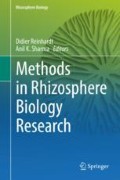Abstract
It is well established that arbuscular mycorrhiza (AM) symbiotic fungi contribute to the scavenging of soil mineral nutrients in exchange for photosynthetically fixed organic carbon in the large majority of land plants. However, plants are naturally interconnected by a common mycorrhizal network (CMN), and the terms of trade as well as developmental interactions between plants connected with a shared fungal partner are still poorly understood. To facilitate the decrypting of such complex relationships, model systems allowing the study of two or more interconnected plants have been developed. Compartmented microcosms were designed to physically separate the roots of studied plants (using meshes) that can in fact only interact through a CMN the integrity of which can be controlled. Here, we report on recently published results relative to the implementation of various specifically designed microcosms to better understand the role in plant-plant relationships of the CMN and that of the AM fungal species involved.
Access this chapter
Tax calculation will be finalised at checkout
Purchases are for personal use only
References
Alho L, Carvalho M, Brito I, Goss MJ (2015) The effect of arbuscular mycorrhiza fungal propagules on the growth of subterranean clover (Trifolium subterraneum L.) under Mn toxicity in ex situ experiments. Soil Use Manag 31:337–344
Babikova Z, Gilbert L, Bruce TJA, Birkett M, Caulfield JC, Woodcock C, Pickett JA, Johnson D (2013) Underground signals carried through common mycelial networks warn neighbouring plants of aphid attack. Ecol Lett 16:835–843
Barto EK, Weidenhamer JD, Cipollini D, Rillig MC (2012) Fungal superhighways: do common mycorrhizal networks enhance below ground communication? Trends Plant Sci 17:633–637
Bever JD, Dickie IA, Facelli E, Facelli JM, Klironomos J, Moora M, Rillig MC, Stock WD, Tibbett M, Zobel M (2010) Rooting theories of plant community ecology in microbial interactions. Trends Ecol Evol 25:468–478
Brígido C, van Tuinen D, Brito I, Alho L, Goss MJ, Carvalho M (2017) Management of the biological diversity of AM fungi by combination of host plant succession and integrity of extraradical mycelium. Soil Biol Biochem 112:237–247
Cameron DD, Neal AL, van Wees SCM, Ton J (2013) Mycorrhiza-induced resistance: more than the sum of its parts? Trends Plant Sci 18:539–545
Gianinazzi S, Gollotte A, Binet MN, van Tuinen D, Redecker D, Wipf D (2010) Agroecology: the key role of arbuscular mycorrhizas in ecosystem services. Mycorrhiza 20:519–530
Janos DP, Scott J, Aristizábal C, Bowman DMJS (2013) Arbuscular-mycorrhizal networks inhibit Eucalyptus tetrodonta seedlings in rain forest soil microcosms. PLoS One 8:e57716
Qiao X, Bei S, Li H, Christie P, Zhang F, Zhang J (2016) Arbuscular mycorrhizal fungi contribute to overyielding by enhancing crop biomass while suppressing weed biomass in intercropping systems. Plant Soil 406:173–185
Ray P, Guo Y, Kolape J, Craven KD (2017) Non-targeted colonization by the endomycorrhizal fungus, Serendipita vermifera, in three weeds typically co-occurring with switchgrass. Front Plant Sci 8:2236
Rillig MC, Wright SF, Eviner VT (2002) The role of arbuscular mycorrhizal fungi and glomalin in soil aggregation: comparing effects of five plant species. Plant Soil 238:325–333
Smith SE, Read DJ (2008) Mycorrhizal symbiosis, Ed 3 edn. Academic, Cambridge
Teste FP, Veneklaas EJ, Dixon KW, Lambers H (2015) Is nitrogen transfer among plants enhanced by contrasting nutrient-acquisition strategies? Plant Cell Environ 38:50–60
Walder F, van der Heijden MGA (2015) Regulation of resource exchange in the arbuscular mycorrhizal symbiosis. Nat Plant 1:15159
Walder F, Niemann H, Natarajan M, Lehmann MF, Boller T, Wiemken A (2012) Mycorrhizal networks: common goods of plants shared under unequal terms of trade. Plant Physiol 159:789–797
Walder F, Brulé D, Koegel S, Wiemken A, Boller T, Courty P-E (2015) Plant phosphorus acquisition in a common mycorrhizal network: regulation of phosphate transporter genes of the Pht1 family in sorghum and flax. New Phytol 205:1632–1645
Weremijewicz J, Janos DP (2013) Common mycorrhizal networks amplify size inequality in Andropogon gerardii monocultures. New Phytol 198:203–213
Weremijewicz J, Sternberg LDSLO, Janos DP (2016) Common mycorrhizal networks amplify competition by preferential mineral nutrient allocation to large host plants. New Phytol 212:461–471
Weremijewicz J, da Silveira Lobo O’Reilly Sternberg L, Janos DP (2018) Arbuscular common mycorrhizal networks mediate intra- and interspecific interactions of two prairie grasses. Mycorrhiza 28:71–83
Acknowledgements
The authors acknowledge the financial support provided by the Plant Health and Environment department from INRA, the Germaine de Stael programme (TRANSBIO 26510SG) and funding bodies within the H2020 ERA-net project, CORE Organic Cofund, and with cofunds from the European Commission (BIOVINE project).
Author information
Authors and Affiliations
Corresponding author
Editor information
Editors and Affiliations
Rights and permissions
Copyright information
© 2019 Springer Nature Singapore Pte Ltd.
About this chapter
Cite this chapter
Bonneau, L., Recorbet, G., van Tuinen, D., Wipf, D., Courty, PE. (2019). Analysis of Common Mycorrhizal Networks in Microcosms. In: Reinhardt, D., Sharma, A. (eds) Methods in Rhizosphere Biology Research. Rhizosphere Biology. Springer, Singapore. https://doi.org/10.1007/978-981-13-5767-1_15
Download citation
DOI: https://doi.org/10.1007/978-981-13-5767-1_15
Published:
Publisher Name: Springer, Singapore
Print ISBN: 978-981-13-5766-4
Online ISBN: 978-981-13-5767-1
eBook Packages: Biomedical and Life SciencesBiomedical and Life Sciences (R0)

